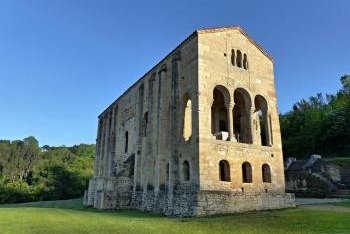
I visited all the 6 sites of this WHS in June 2016. I stayed for 2 nights in a hotel near Monte Naranco. The first day I visited Santa Maria del Naranco, San Miguel de Lillo and Santa Cristina de Lena. The first two can only be visited with a guided visit in Spanish and tickets can be bought at Santa Maria del Naranco. Next to these two sites there is a small information centre as these are the most visited sites being quite close to Oviedo by car/public transport. Plan ahead not to visit on Mondays as pretty much everything would be closed. Santa Maria del Naranco is mostly famous for its peculiar architecture as well as for the unique engravings and sculpted capitels. San Miguel de Lillo has a few mural painting left although most of it is damaged due to humidity and sunlight. Photography is not allowed inside this church. Don't expect elaborate paintings as these sites are quite old. Make sure to pay attention to the beautifully carved walls on the sides of the entrance which can be appreciated just before exiting as when the second door is opened for people to go out, the sunlight reveals the great detail. Next I drove just outside Pola de Lena to visit Santa Cristina de Lena. Make sure to have a GPS or else follow the signs which direct you off the highway through Lena proper. This church has the best natural setting and panorama once you arrive up the hill but at the same time beneath the hill are two huge highways. There are two ways to visit. Either via a steep walk uphill or else through a shaded path just opposite a few parking spaces. I'd recommend the latter as the old lady who looks after the church and has the key lives just next to this path. Not many people visit this site so when there are no visitors around she looks after her horses and goats and lets them roam freely around the small church. Should you opt for the uphill route she might not see you and you'll either have to call or else you will have to backtrack to where she lives. The church's interior is the most well worth viewing in my opinion as its architecture is truly unique. The intricately carved vestibule and royal tribune on different levels are well worth viewing if only for the comparison between Asturian pre-romanesque and Visigoth influences. The highlight is the presbytery elevated above floor level separated by three arches on marble columns. All three churches have beautifully carved windows, probably the best examples are those at San Miguel de Lillo, even though they are protected with a piece of glass. On the next day I focused more on the sites in Oviedo which were added later. The Fuente de Foncalada is hidden in the concrete jungle just after Cider Street while the Camara Santa together with the Cripta de Santa Leocadia are the main highlight of the Cathedral of San Salvador in Oviedo. To enter you will have to pay the rather expensive 5 euro entrance fee or 7 euros including the audio guide. The Camino Primitivo and the Camino de la Costa pass through Oviedo and it is said that who goes to Santiago but not to the Oviedo catedral, visits the servant but not the Lord. The catedral itself is not inscribed but the Camara Santa together with the Cripta de Santa Leocadia are only accessible through the catedral. There are three main things to see here. The main highlight is the Camara Santa which is up one floor to the right of the main altar. In fact it is the upper floor of the Asturian building. It houses the cathedral's main treasures: the Holy Shroud, the omnipresent Cruz de la Victoria, the Holy Ark and the Agate treasure chest. Moreover you can see the apostles carved in the columns supporting the chamber. Downstairs, through the cloister, you can visit the lower floor of the Asturian construction which is now used as the Cripta de Santa Leocadia. The highlight worth visiting though is outside towards the cemetery where you can see the exterior of both as one whole building. There are 4 metal UNESCO plaques proudly displaying this inscription. One can be found in the small cemetery, one just opposite the Fuente, one in front of Santa Maria del Naranco and one in front of San Julian de los Prados. The latter is the last site I visited while in Oviedo. It is quite a long walk away from the city centre and just beside a very busy main road. However it is worth visiting not only for its elegant exterior but mostly for the best preserved murals of the series. All in all I think that these minor sites deserve their place on the list and while visiting I couldn't help comparing this inscription with the Longobards' inscription in Italy. Both inscriptions are valid additions to the list and both have enjoyable cities or towns nearby which are worth visiting if only for the culinary delights they have on offer. In both cases, this really helped to finish off my visits with a smile and a full stomach.
More on
Comments
No comments yet.
